A New Double-Inclination Oblique Model to Simulate Drilling of GFRP/Al-Based Stacks: A Thermomechanical Approach
Abstract
1. Introduction
2. Materials and Methods
2.1. Specimen Preparation and Drilling Conditions
2.2. Estimation of Heat Generation in Hybrid GFRP/Al
2.3. Estimation of Heat Flux Applied to GFRP
2.4. Estimation of Heat Flux Applied to Aluminum
3. Constitutive Approach
3.1. Heat Transfer Model for Hybrid Composite
3.2. GFRP Constitutive Behavior
3.2.1. Temperature-Dependent Properties
3.2.2. Damage Initiation Criteria
3.2.3. Damage Evolution
3.3. Aluminum Constitutive Behavior
3.4. Oblique Cutting Geometry
3.5. Finite Element Model
4. Results and Discussion
4.1. Impact of Stacking Arrangement and Cutting Speed on GFRP/Al Interface Temperature
4.1.1. GFRP → Al Cutting Mode
4.1.2. Al → GFRP Cutting Mode
4.2. Effect of Cutting Speed on Temperature Evolution
4.3. Damage Contours Analysis
5. Conclusions
- Increasing spindle speed significantly affects the temperature distribution and thermal subsurface damage within the composite structure. When the tool engages first the GFRP phase (GFRP → Al), temperature stabilizes at a speed of approximately 308 m/min. However, when the tool engages first the Al phase (Al → GFRP), stabilization is achieved at about 471 m/min.
- The choice of cutting arrangement critically affects the temperature distribution and subsurface damage. It was revealed that attacking from the GFRP phase results in higher interface temperatures than when attacking from the aluminum side. This is likely due to GFRP’s lower thermal conductivity compared to that of aluminum, which restricts heat dissipation and causes higher temperature buildup in the GFRP layer during cutting.
- If compared with drilling tests, the proposed model shows high reliability in predicting drilling behavior regardless of the stacking arrangement. The findings make it possible to derive an exponential temperature law, which not only predicts temperature changes versus the cutting speed, but also identifies thermal saturation at the interface. This make it possible to reveal the critical cutting speed range to avoid when drilling such a structure.
- The heat transfer between constitutive phases influences the subsurface damage at the interface. Heat localization is typically detected at the interface due to temperature overlaps exceeding the glass transition point . Heat generated in the metallic phase flows to the GFRP phase and elevates the temperature throughout the interface. The temperature gap between the phases yields a severe discontinuity along the interface, which promotes failure initiation and ultimately compromises the integrity of the hybrid structure during drilling.
Author Contributions
Funding
Institutional Review Board Statement
Data Availability Statement
Acknowledgments
Conflicts of Interest
References
- Franz, G.; Vantomme, P.; Hassan, M.H. A review on drilling of multilayer fiber-reinforced polymer composites and aluminum stacks: Optimization of strategies for improving the drilling performance of aerospace assemblies. Fibers 2022, 10, 78. [Google Scholar] [CrossRef]
- Pecat, O.; Meyer, I. Low frequency vibration assisted drilling of aluminum alloys. Adv. Mater. Res. 2013, 769, 131–138. [Google Scholar] [CrossRef]
- Wang, H.P.; Dai, J.G.; Wang, X.Z. Improved temperature compensation of fiber Bragg grating-based sensors applied to structures under different loading conditions. Opt. Fiber Technol. 2021, 63, 102506. [Google Scholar] [CrossRef]
- Khoran, M.; Ghabezi, P.; Frahani, M.; Besharati, M.K. Investigation of drilling composite sandwich structures. Int. J. Adv. Manuf. Technol. 2015, 76, 1927–1936. [Google Scholar] [CrossRef]
- Erturk, A.T.; Vatansever, F.; Yarar, E.; Guven, E.A.; Sinmazcelik, T. Effects of cutting temperature and process optimization in drilling of GFRP composites. J. Compos. Mater. 2021, 55, 235–249. [Google Scholar] [CrossRef]
- Salem, B.; Mkaddem, A.; Habak, M.; Dobah, Y.; Elfarhani, M.; Jarraya, A. Investigation of temperature at Al/Glass Fiber-Reinforced Polymer interfaces when drilling composites of different stacking arrangements. Polymers 2024, 16, 2823. [Google Scholar] [CrossRef] [PubMed]
- Kuo, C.L.; Soo, S.L.; Aspinwall, D.K.; Carr, C.; Bradley, S.; M’Saoubi, R.; Leahy, W. Development of single step drilling technology for multilayer metallic-composite stacks using uncoated and PVD coated carbide tools. J. Manuf. Process. 2018, 31, 286–300. [Google Scholar] [CrossRef]
- Raja, R.; Krishnaraj, V.; Jannet, S. Experimental investigation of high-speed drilling of Al/GFRP multi materials. Indian J. Sci. Technol. 2017, 10, 1–9. [Google Scholar] [CrossRef][Green Version]
- Joyson Selvakumar, S.; Muthiah Muralidharan, S. performance analysis of drills with structured surfaces when drilling CFRP/AA7075 stack under MQL condition. J. Manuf. Process. 2023, 89, 194–219. [Google Scholar] [CrossRef]
- Beuscart, T.; Arrazola, P.J.; Tinel, N.; Ducobu, F. Effect of cutting conditions on surface integrity when robotic drilling of Aluminum 6082-GFRP stacks. Proc. CIRP 2024, 123, 428–433. [Google Scholar] [CrossRef]
- Li, C.; Zhao, Y.; Qiu, X.; Li, S.; Niu, Q.; Li, P.; Jo Ko, T. Interface mechanical damage mechanism in machining Carbon Fiber-Reinforced Plastic/Ti stacks based on a three-dimensional microscopic oblique cutting model. Compos. Struct. 2022, 279, 114737. [Google Scholar] [CrossRef]
- Brinksmeier, E.; Fangmann, S.; Rentsch, R. Drilling of composites and resulting surface integrity. CIRP Ann. Manuf. Technol. 2011, 60, 57–60. [Google Scholar] [CrossRef]
- Manzoor, S.; Ud Din, I.; Giasin, K.; Köklü, U.; Khan, K.A.; Panier, S. Three-dimensional finite element modeling of drilling-induced damage in S2/FM94 Glass-Fiber-Reinforced Polymers (GFRPs). Materials 2022, 15, 7052. [Google Scholar] [CrossRef]
- Janakiraman, A.; Pemmasani, S.; Sheth, S.; Kannan, C.; Balan, A.S.S. Experimental investigation and parametric optimization on hole quality assessment during drilling of CFRP/GFRP/Al stacks. J. Inst. Eng. 2020, 101, 291–302. [Google Scholar] [CrossRef]
- Jessy, K.; Satish kumar, S.; Dinakaran, D.; Seshagiri Rao, V. Influence of different cooling methods on drill temperature in drilling GFRP. Int. J. Adv. Manuf. Technol. 2015, 76, 609–621. [Google Scholar] [CrossRef]
- Chen, C.; Wang, A.; Zheng, Z.; Zhao, Q.; Shi, Z.; Bao, Y. A study on drilling of CFRP/Ti stacks: Temperature field and thermal damage of the interface region. Materials 2023, 16, 2586. [Google Scholar] [CrossRef]
- Wei, Y.; An, Q.; Ming, W.; Chen, M. Effect of drilling parameters and tool geometry on drilling performance in drilling Carbon Fiber-reinforced Plastic/Titanium alloy stacks. Adv. Mech. Eng. 2016, 8, 1–16. [Google Scholar] [CrossRef]
- Salem, B.; Mkaddem, A.; Ghazali, S.; Habak, M.; Felemban, B.F.; Jarraya, A. Towards an advanced modeling of hybrid composite cutting: Heat discontinuity at interface region. Polymers 2023, 15, 1955. [Google Scholar] [CrossRef]
- Ge, J.; Chen, G.; Su, J.; Zou, Y.; Ren, C.; Qin, X.; Wang, G. Effect of cooling strategies on performance and mechanism of helical milling of CFRP/Ti-6Al-4 V stacks. Chin. J. Aeronaut. 2022, 35, 388–403. [Google Scholar] [CrossRef]
- Sun, L.; Gao, H.; Wang, B.; Bao, Y.; Wang, M.; Ma, S. Mechanism of reduction of damage during helical milling of titanium/CFRP/aluminum stacks. Int. J. Adv. Manuf. Technol. 2020, 107, 4741–4753. [Google Scholar] [CrossRef]
- Zitoune, R.; Collombet, F.; Lachaud, F.; Piquet, R.; Pasquet, F. Experiment–calculation comparison of the cutting conditions representative of the long fiber composite drilling phase. Compos. Sci. Technol. 2005, 65, 455–466. [Google Scholar] [CrossRef]
- Mohan, N.S.; Kulkarni, S.M.; Ramachandra, A. Delamination analysis in drilling process of glass fiber reinforced plastic (GFRP) composite materials. J. Mater. Process. Technol. 2007, 186, 265–271. [Google Scholar] [CrossRef]
- Abd-Elwahed, M.S.; Khashaba, U.A.; Ahmed, K.I.; Eltaher, M.A.; Najjar, I.; Melaibari, A.; Abdraboh, A.M. Experimental and numerical FEM of woven GFRP composites during drilling. Struct. Eng. Mech. 2011, 80, 503–522. [Google Scholar] [CrossRef]
- Aksu, B.; Çelebi, C.; Budak, E. An experimental investigation of oblique cutting mechanics. Mach. Sci. Technol. 2016, 20, 495–521. [Google Scholar] [CrossRef]
- Liu, C.; Xu, W.; Jin, Y.; Jiang, X.; Yang, T. Mechanistic force modeling in drilling of SiCp/Al matrix composites considering a comprehensive abrasive particle model. Int. J. Adv. Manuf. Technol. 2020, 109, 421–442. [Google Scholar] [CrossRef]
- Xu, X.; Jin, X. 3-D finite element modeling of sequential oblique cutting of unidirectional carbon fiber reinforced polymer. Compos. Struct. 2021, 256, 113127. [Google Scholar] [CrossRef]
- Wang, F.J.; Yin, J.W.; Ma, J.W.; Niu, B. Heat partition in dry orthogonal cutting of unidirectional CFRP composite laminates. Compos. Struct. 2018, 197, 28–38. [Google Scholar] [CrossRef]
- Salem, B.; Mkaddem, A.; Al Rubaiee, S.S.S.; Al-Zahrani, A.; Bin Mahfouz, A.S.O.; Jarraya, A. Numerical investigation of thermomechanical damage in CFRP composites. Des. Model. Mech. Syst. 2022, 7, 59–66. [Google Scholar] [CrossRef]
- Salem, B.; Mkaddem, A.; Jarraya, A. Interface behavior when drilling GFRP/Al-based composites: Temperature analysis. Adv. Mater. Mech. Manuf. 2024, 3, 196–203. [Google Scholar] [CrossRef]
- Salem, B.; Mkaddem, A.; Rubaiee, S.; Bin Mahfouz, A.S.; Jarraya, A. Combined approach for modeling progressive damage in unidirectional CFRP composites. Adv. Mater. Mech. Manuf. 2021, 2, 308–316. [Google Scholar] [CrossRef]
- Mane, S.; Joshi, S.S.; Karagadde, S.; Kapoor, S.G. Modeling of variable friction and heat partition ratio at the chip-tool interface during orthogonal cutting of Ti-6Al-4V. J. Manuf. Process. 2020, 55, 254–267. [Google Scholar] [CrossRef]
- Fleischer, J.; Pabst, R.; Kelemen, S. Heat flow simulation for dry machining of power train castings. CIRP Ann. Manuf. Technol. 2007, 56, 117–122. [Google Scholar] [CrossRef]
- Gibson, A.G.; Wu, Y.S.; Evans, J.T.; Mouritz, A.P. Laminate theory analysis of composites under load in fire. J. Compos. Mater. 2006, 40, 639–658. [Google Scholar] [CrossRef]
- Jia, Y.Z.; Chen, C.; Wang, F.J.; Ma, J.W.; Yang, F. Three-dimensional oblique cutting model for sub-surface damage analysis in CFRP/Ti stack composite machining. Int. J. Adv. Manuf. Technol. 2018, 96, 643–655. [Google Scholar] [CrossRef]
- Matzenmiller, A.; Lubliner, J.; Taylor, R.L. A constitutive model for anisotropic damage in fiber-composites. Mech. Mater. 1995, 20, 125–152. [Google Scholar] [CrossRef]
- Khan, S.H.; Sharma, A.P. Progressive damage modeling and interface delamination of cross ply laminates subjected to low velocity impact. J. Strain Anal. Eng. Des. 2018, 53, 435–445. [Google Scholar] [CrossRef]
- Gordon, R.J.; William, H.C. Fracture characteristics of three metals subjected to various strains, strain rates, temperatures and pressures. Eng. Fract. Mech. 1985, 21, 31–48. [Google Scholar] [CrossRef]
- Chen, G.; Lu, L.; Ke, Z.; Qin, X.; Ren, C. Influence of constitutive models on finite element simulation of chip formation in orthogonal cutting of Ti-6Al-4V alloy. Proc. Manuf. 2019, 33, 530–537. [Google Scholar] [CrossRef]
- Stabler, G.V. The chip flow law and its consequences. Adv. Mach. Tool Des. Res. 1964, 5, 243–251. [Google Scholar]
- Soldani, X.; Santiuste, C.; Muñoz-Sánchez, A.; Miguélez, M.H. Influence of tool geometry and numerical parameters when modeling orthogonal cutting of LFRP composites. Compos. Part A Appl. Sci. Manuf. 2011, 42, 1205–1216. [Google Scholar] [CrossRef]
- Haddag, B.; Atlati, S.; Nouari, M.; Moufki, A. Dry machining aeronautical aluminum alloy AA2024-T351: Analysis of cutting forces, chip segmentation and built-up edge formation. Metals 2016, 6, 197. [Google Scholar] [CrossRef]
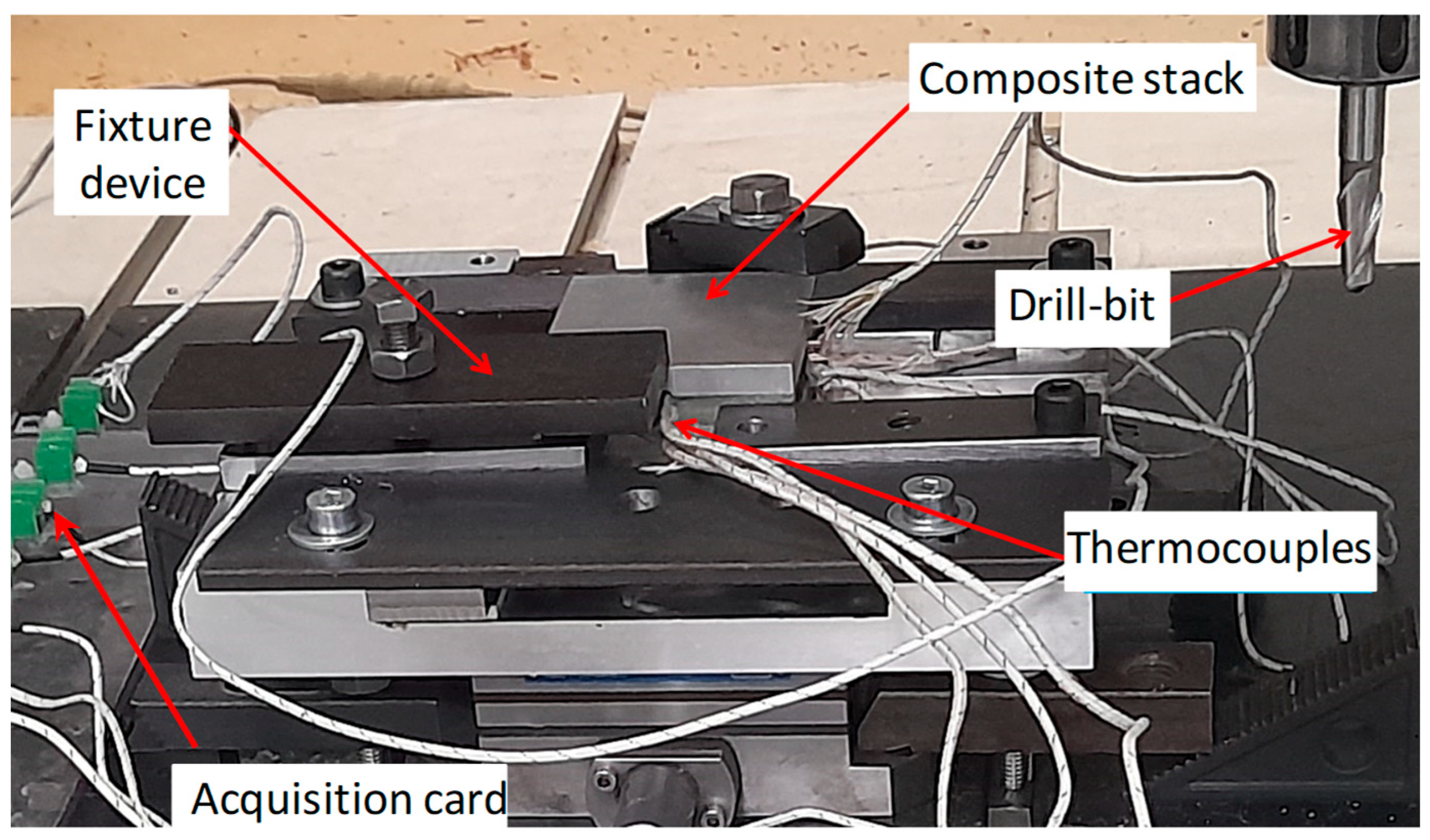
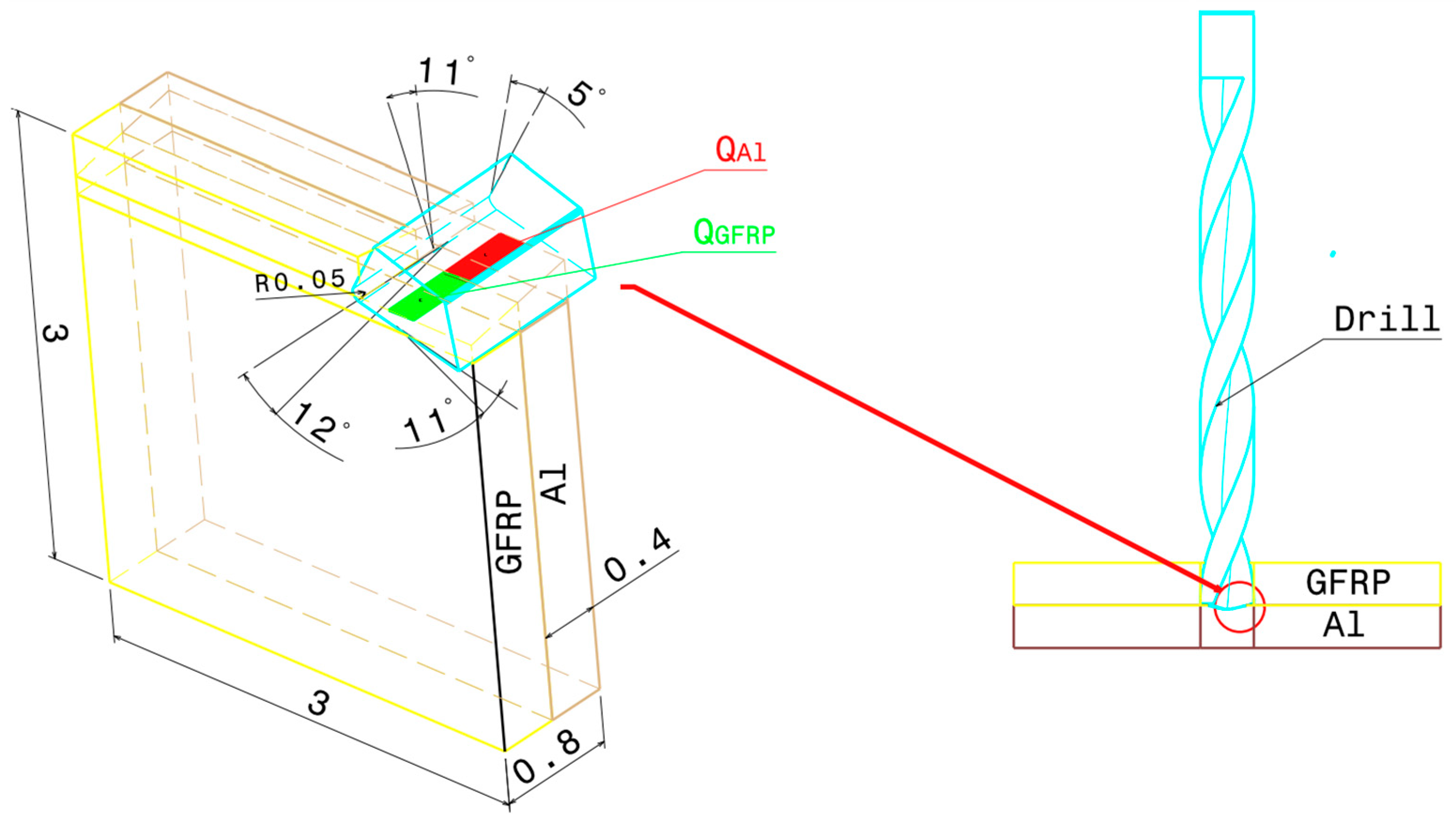
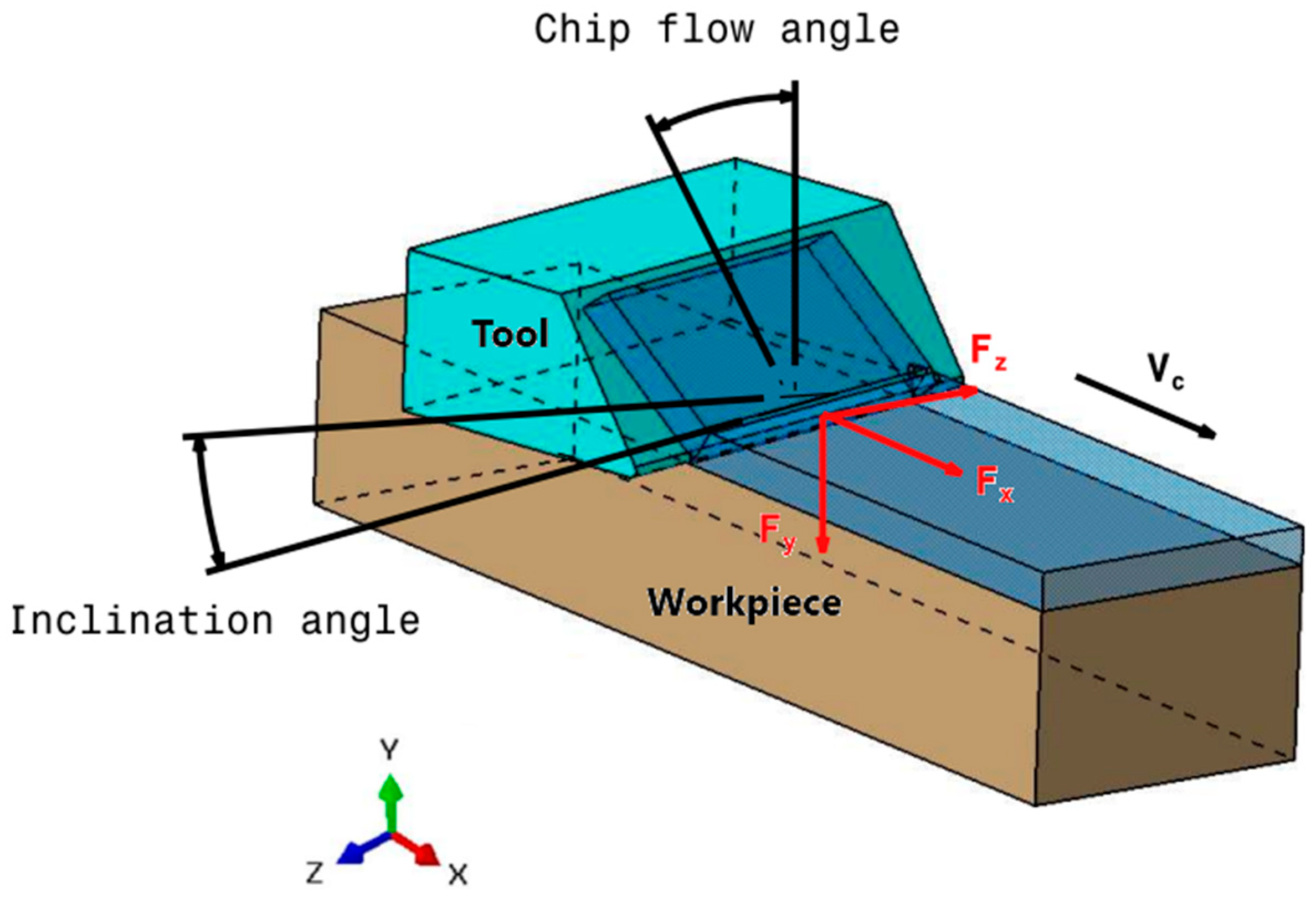
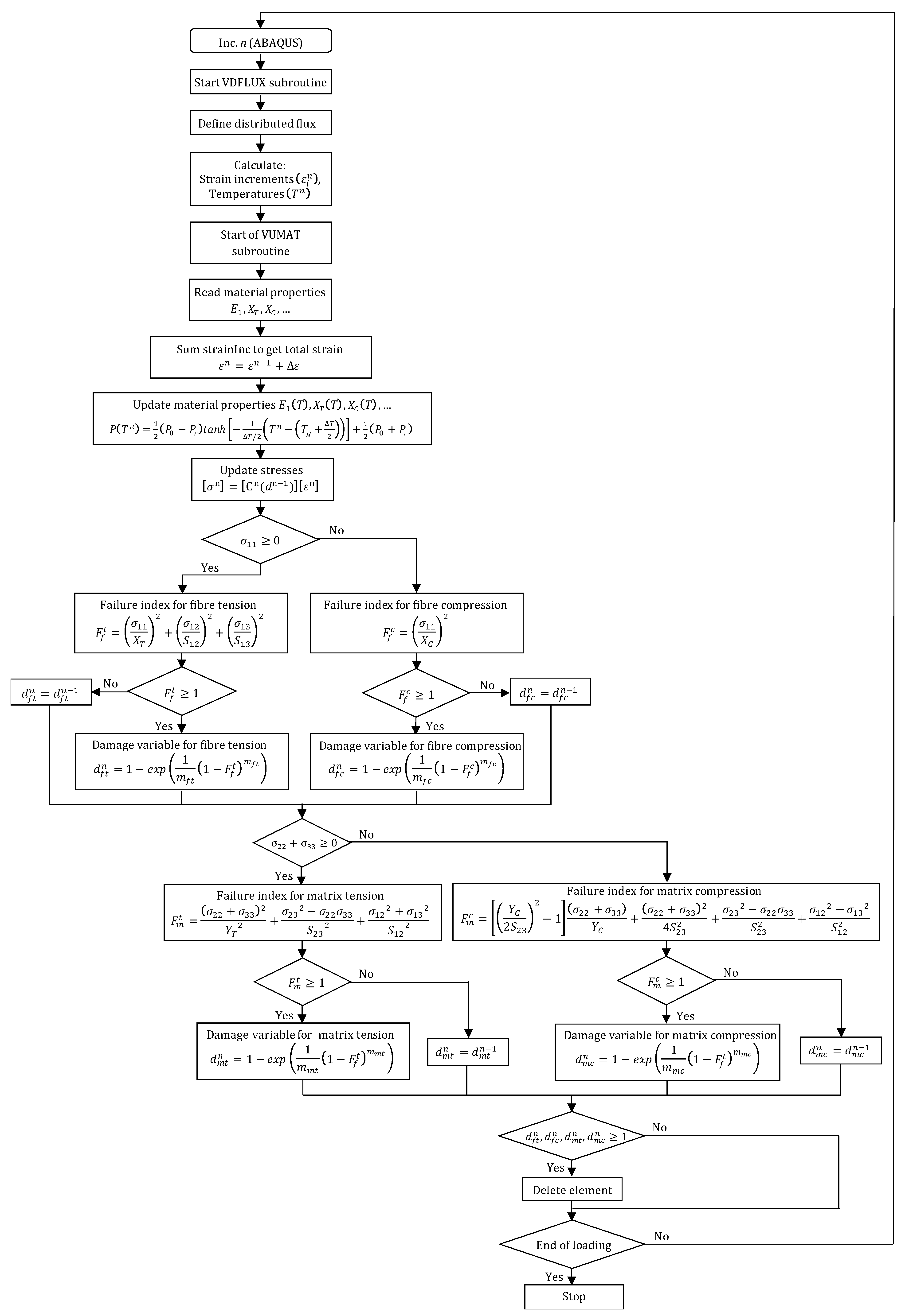
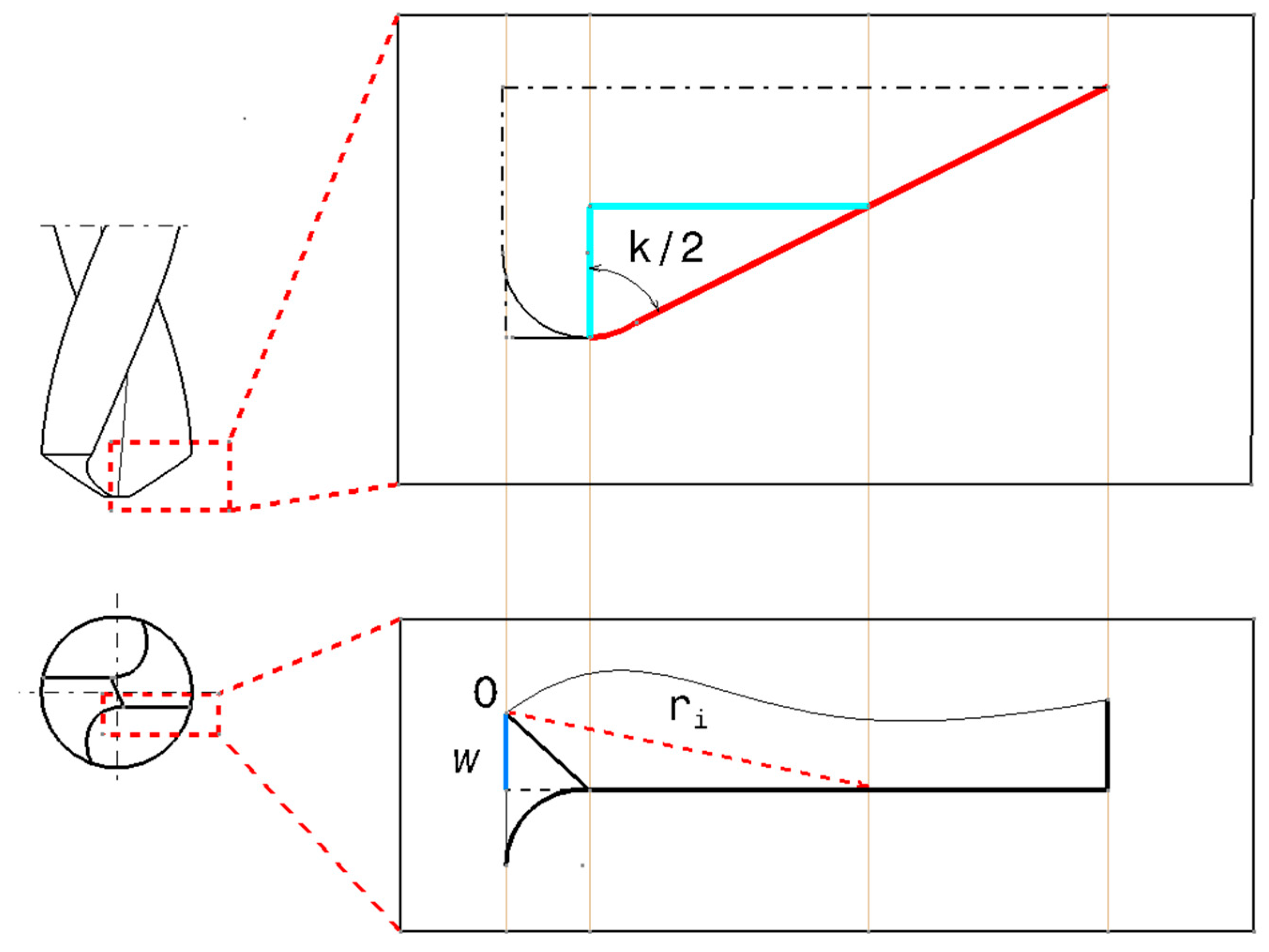
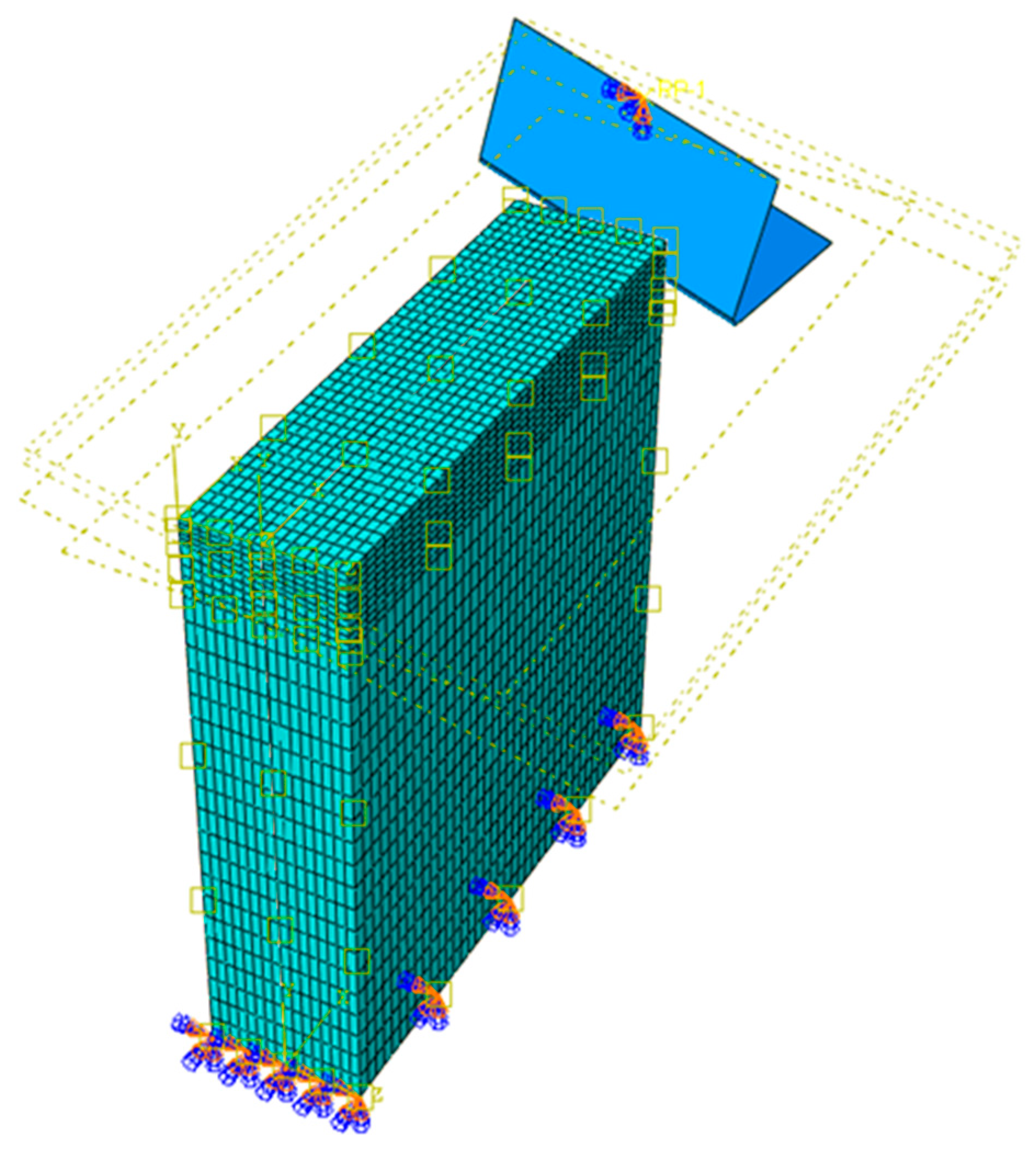
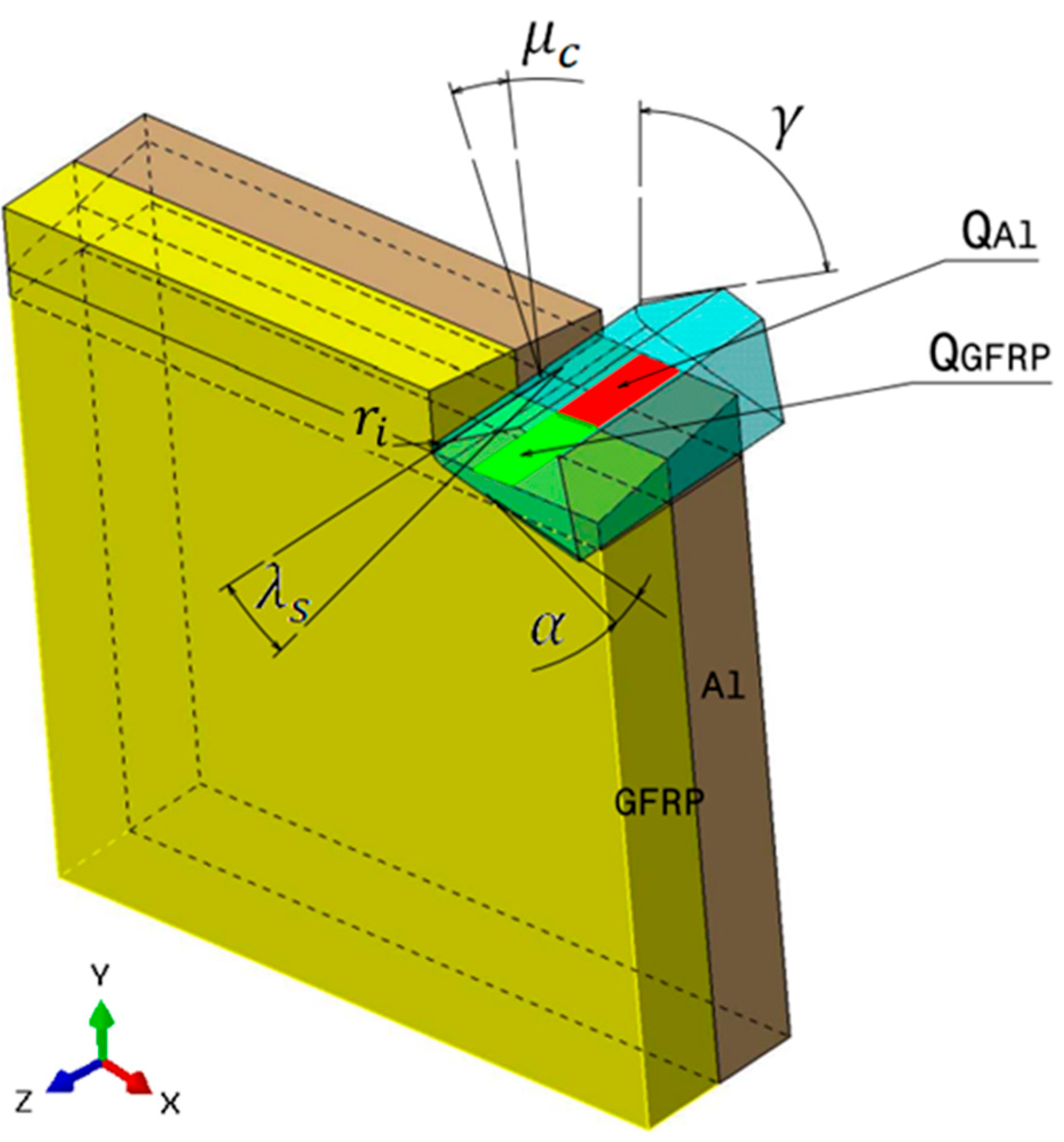



| Parameters | Symbol | Value |
|---|---|---|
| Density | 1230 | |
| Longitudinal Young’s modulus in-plan | 48 | |
| Transverse Young’s modulus in-plan | 12 | |
| Transverse Young’s modulus normal-to-plan | 12 | |
| In-plane shear modulus | 6 | |
| Shear modulus in plane 1–3 | 6 | |
| Shear modulus in plane 2–3 | 4 | |
| In-plane Poisson’s ratio | 0.28 | |
| Transverse Poisson’s ratio in 1–3 plan | 0.28 | |
| Transverse Poisson’s ratio in 2–3 plan | 0.35 | |
| Longitudinal tensile strength in-plan | 1200 | |
| Longitudinal compression strength in-plan | 800 | |
| Transverse tensile strength in-plan | 59 | |
| Transverse tensile strength normal-to-plan | 128 | |
| Transverse compression strength in-plan | 59 | |
| Transverse compression strength normal-to-plan | 128 | |
| In-plane shear strength | 25 | |
| Transverse shear strength in plane 1–3 | 25 | |
| Transverse shear strength in plane 2–3 | 25 | |
| In-plane longitudinal thermal conductivity | 2.38 | |
| Transverse thermal conductivity in-plane | 0.39 | |
| Transverse thermal conductivity normal-to-plane | 0.39 | |
| Specific heat | 700 |
| Parameters | Symbol | Value |
|---|---|---|
| Density | 2770 | |
| Young’s modulus | 73 | |
| Poisson ratio | 0.33 | |
| Melting temperature | 520 | |
| Room temperature | 25 | |
| Thermal conductivity | 120 | |
| Thermal expansion coefficient | ||
| Specific heat | 875 | |
| Viscoplastic parameters | 352 | |
| 440 | ||
| 0.0083 | ||
| 0.42 | ||
| 1 | ||
| Damage parameters | 0.13 | |
| 0.13 | ||
| 1.5 | ||
| 0.011 | ||
| 0 |
| Parameters | Symbol | Value |
|---|---|---|
| Tool rake angle | 11 | |
| Tool clearance angle | 5 | |
| Inclination angle | 12 | |
| Chip flow angle | 11 | |
| Tool-tip radius | 5 | |
| Specimen size | ||
| Cutting speed | 71–94–119–142 | |
| Depth of cut | 6 | |
| Fiber orientation | 0 | |
| Friction coefficient | 0.3 |
| Cutting Speed | GFRP Plate | Al Plate |
|---|---|---|
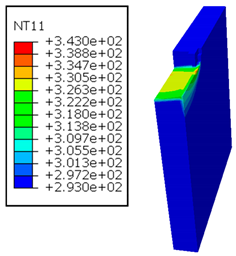 | 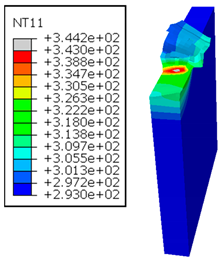 | |
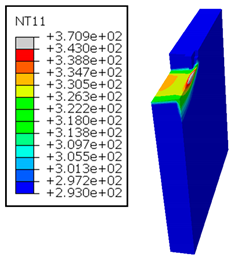 |  | |
 |  | |
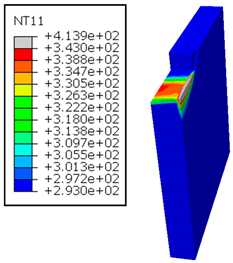 | 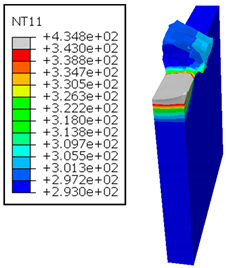 |
| Al Plate | GFRP Plate | |
|---|---|---|
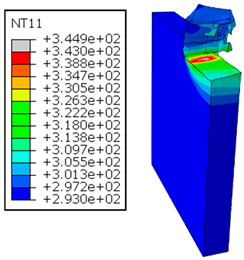 |  | |
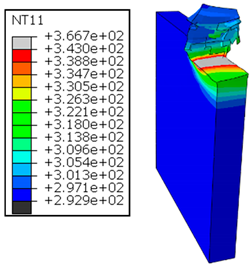 | 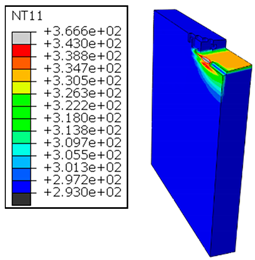 | |
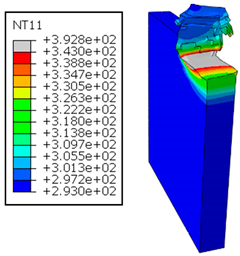 |  | |
 |  |
Disclaimer/Publisher’s Note: The statements, opinions and data contained in all publications are solely those of the individual author(s) and contributor(s) and not of MDPI and/or the editor(s). MDPI and/or the editor(s) disclaim responsibility for any injury to people or property resulting from any ideas, methods, instructions or products referred to in the content. |
© 2025 by the authors. Licensee MDPI, Basel, Switzerland. This article is an open access article distributed under the terms and conditions of the Creative Commons Attribution (CC BY) license (https://creativecommons.org/licenses/by/4.0/).
Share and Cite
Salem, B.; Mkaddem, A.; Habak, M.; Dobah, Y.; Jarraya, A. A New Double-Inclination Oblique Model to Simulate Drilling of GFRP/Al-Based Stacks: A Thermomechanical Approach. Polymers 2025, 17, 1047. https://doi.org/10.3390/polym17081047
Salem B, Mkaddem A, Habak M, Dobah Y, Jarraya A. A New Double-Inclination Oblique Model to Simulate Drilling of GFRP/Al-Based Stacks: A Thermomechanical Approach. Polymers. 2025; 17(8):1047. https://doi.org/10.3390/polym17081047
Chicago/Turabian StyleSalem, Brahim, Ali Mkaddem, Malek Habak, Yousef Dobah, and Abdessalem Jarraya. 2025. "A New Double-Inclination Oblique Model to Simulate Drilling of GFRP/Al-Based Stacks: A Thermomechanical Approach" Polymers 17, no. 8: 1047. https://doi.org/10.3390/polym17081047
APA StyleSalem, B., Mkaddem, A., Habak, M., Dobah, Y., & Jarraya, A. (2025). A New Double-Inclination Oblique Model to Simulate Drilling of GFRP/Al-Based Stacks: A Thermomechanical Approach. Polymers, 17(8), 1047. https://doi.org/10.3390/polym17081047







